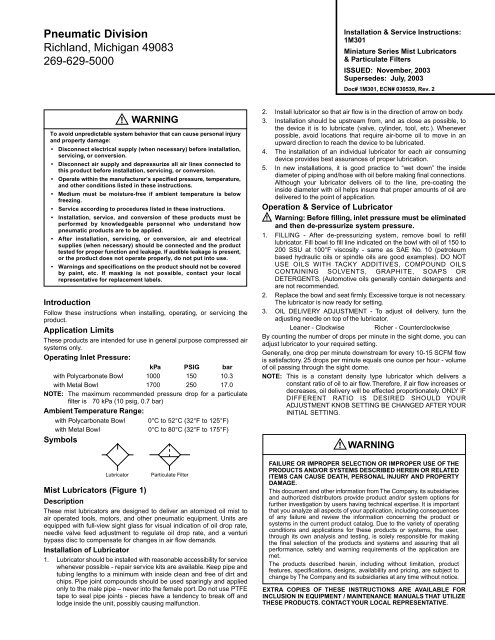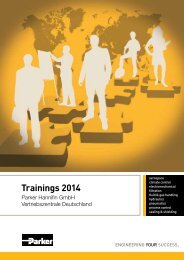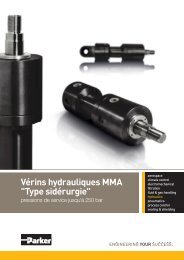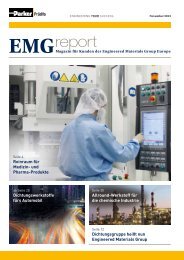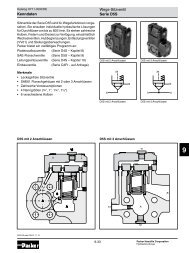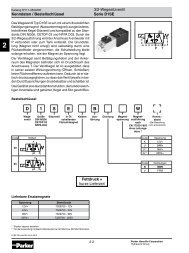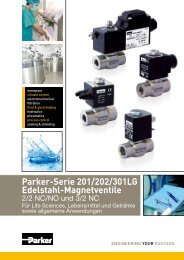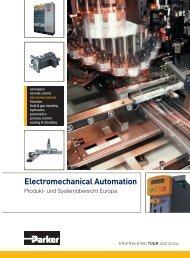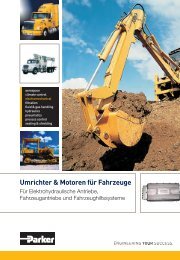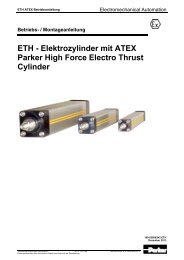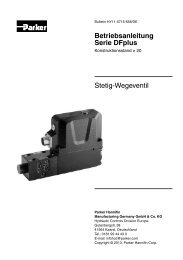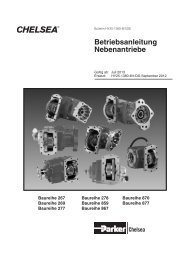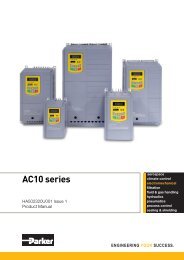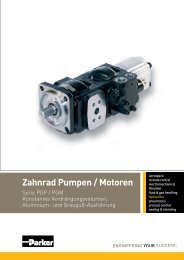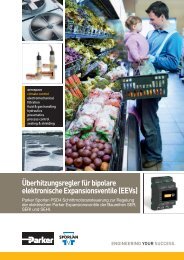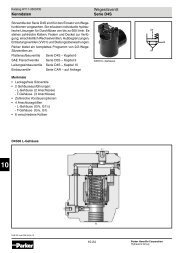L50 Injection Lubricator - Parker
L50 Injection Lubricator - Parker
L50 Injection Lubricator - Parker
You also want an ePaper? Increase the reach of your titles
YUMPU automatically turns print PDFs into web optimized ePapers that Google loves.
Pneumatic Division<br />
Richland, Michigan 49083<br />
269-629-5000<br />
Introduction<br />
!<br />
Follow these instructions when installing, operating, or servicing the<br />
product.<br />
Application Limits<br />
These products are intended for use in general purpose compressed air<br />
systems only.<br />
Operating Inlet Pressure:<br />
kPa PSIG bar<br />
with Polycarbonate Bowl 1000 150 10.3<br />
with Metal Bowl 1700 250 17.0<br />
NOTE: The maximum recommended pressure drop for a particulate<br />
filter is 70 kPa (10 psig, 0.7 bar)<br />
Ambient Temperature Range:<br />
with Polycarbonate Bowl 0°C to 52°C (32°F to 125°F)<br />
with Metal Bowl 0°C to 80°C (32°F to 175°F)<br />
Symbols<br />
<strong>Lubricator</strong><br />
Mist <strong>Lubricator</strong>s (Figure 1)<br />
WARNING<br />
To avoid unpredictable system behavior that can cause personal injury<br />
and property damage:<br />
• Disconnect electrical supply (when necessary) before installation,<br />
servicing, or conversion.<br />
Disconnect air supply and depressurize all air lines connected to<br />
this product before installation, servicing, or conversion.<br />
Operate within the manufacturer’s specified pressure, temperature,<br />
and other conditions listed in these instructions.<br />
Medium must be moisture-free if ambient temperature is below<br />
freezing.<br />
Service according to procedures listed in these instructions.<br />
Installation, service, and conversion of these products must be<br />
performed by knowledgeable personnel who understand how<br />
pneumatic products are to be applied.<br />
After installation, servicing, or conversion, air and electrical<br />
supplies (when necessary) should be connected and the product<br />
tested for proper function and leakage. If audible leakage is present,<br />
or the product does not operate properly, do not put into use.<br />
Warnings and specifications on the product should not be covered<br />
by paint, etc. If masking is not possible, contact your local<br />
representative for replacement labels.<br />
Particulate Filter<br />
Description<br />
These mist lubricators are designed to deliver an atomized oil mist to<br />
air operated tools, motors, and other pneumatic equipment. Units are<br />
equipped with full-view sight glass for visual indication of oil drop rate,<br />
needle valve feed adjustment to regulate oil drop rate, and a venturi<br />
bypass disc to compensate for changes in air flow demands.<br />
Installation of <strong>Lubricator</strong><br />
1. <strong>Lubricator</strong> should be installed with reasonable accessibility for service<br />
whenever possible - repair service kits are available. Keep pipe and<br />
tubing lengths to a minimum with inside clean and free of dirt and<br />
chips. Pipe joint compounds should be used sparingly and applied<br />
only to the male pipe – never into the female port. Do not use PTFE<br />
tape to seal pipe joints - pieces have a tendency to break off and<br />
lodge inside the unit, possibly causing malfunction.<br />
Installation & Service Instructions:<br />
1M301<br />
Miniature Series Mist <strong>Lubricator</strong>s<br />
& Particulate Filters<br />
ISSUED: November, 2003<br />
Supersedes: July, 2003<br />
Doc# 1M301, ECN# 030539, Rev. 2<br />
2. Install lubricator so that air flow is in the direction of arrow on body.<br />
3. Installation should be upstream from, and as close as possible, to<br />
the device it is to lubricate (valve, cylinder, tool, etc.). Whenever<br />
possible, avoid locations that require air-borne oil to move in an<br />
upward direction to reach the device to be lubricated.<br />
4. The installation of an individual lubricator for each air consuming<br />
device provides best assurances of proper lubrication.<br />
5. In new installations, it is good practice to “wet down” the inside<br />
diameter of piping and/hose with oil before making final connections.<br />
Although your lubricator delivers oil to the line, pre-coating the<br />
inside diameter with oil helps insure that proper amounts of oil are<br />
delivered to the point of application.<br />
Operation & Service of <strong>Lubricator</strong><br />
! Warning: Before filling, inlet pressure must be eliminated<br />
and then de-pressurize system pressure.<br />
1. FILLING - After de-pressurizing system, remove bowl to refill<br />
lubricator. Fill bowl to fill line indicated on the bowl with oil of 150 to<br />
200 SSU at 100°F viscosity - same as SAE No. 10 (petroleum<br />
based hydraulic oils or spindle oils are good examples). DO NOT<br />
USE OILS WITH TACKY ADDITIVES, COMPOUND OILS<br />
CONTAINING SOLVENTS, GRAPHITE, SOAPS OR<br />
DETERGENTS. (Automotive oils generally contain detergents and<br />
are not recommended.<br />
2. Replace the bowl and seat firmly. Excessive torque is not necessary.<br />
The lubricator is now ready for setting.<br />
3. OIL DELIVERY ADJUSTMENT - To adjust oil delivery, turn the<br />
adjusting needle on top of the lubricator.<br />
Leaner - Clockwise Richer - Counterclockwise<br />
By counting the number of drops per minute in the sight dome, you can<br />
adjust lubricator to your required setting.<br />
Generally, one drop per minute downstream for every 10-15 SCFM flow<br />
is satisfactory. 25 drops per minute equals one ounce per hour - volume<br />
of oil passing through the sight dome.<br />
NOTE: This is a constant density type lubricator which delivers a<br />
constant ratio of oil to air flow. Therefore, if air flow increases or<br />
decreases, oil delivery will be effected proportionately. ONLY IF<br />
DIFFERENT RATIO IS DESIRED SHOULD YOUR<br />
ADJUSTMENT KNOB SETTING BE CHANGED AFTER YOUR<br />
INITIAL SETTING.<br />
!<br />
WARNING<br />
FAILURE OR IMPROPER SELECTION OR IMPROPER USE OF THE<br />
PRODUCTS AND/OR SYSTEMS DESCRIBED HEREIN OR RELATED<br />
ITEMS CAN CAUSE DEATH, PERSONAL INJURY AND PROPERTY<br />
DAMAGE.<br />
This document and other information from The Company, its subsidiaries<br />
and authorized distributors provide product and/or system options for<br />
further investigation by users having technical expertise. It is important<br />
that you analyze all aspects of your application, including consequences<br />
of any failure and review the information concerning the product or<br />
systems in the current product catalog. Due to the variety of operating<br />
conditions and applications for these products or systems, the user,<br />
through its own analysis and testing, is solely responsible for making<br />
the final selection of the products and systems and assuring that all<br />
performance, safety and warning requirements of the application are<br />
met.<br />
The products described herein, including without limitation, product<br />
features, specifications, designs, availability and pricing, are subject to<br />
change by The Company and its subsidiaries at any time without notice.<br />
EXTRA COPIES OF THESE INSTRUCTIONS ARE AVAILABLE FOR<br />
INCLUSION IN EQUIPMENT / MAINTENANCE MANUALS THAT UTILIZE<br />
THESE PRODUCTS. CONTACT YOUR LOCAL REPRESENTATIVE.


